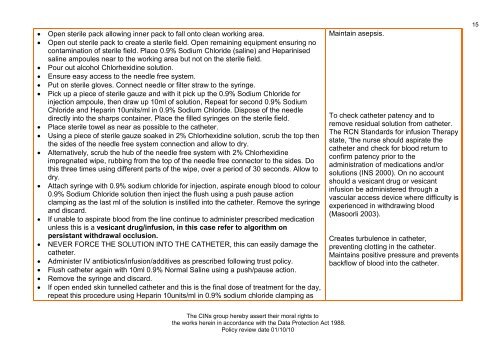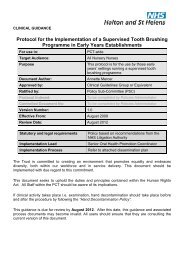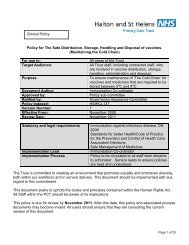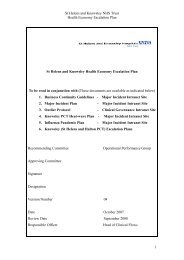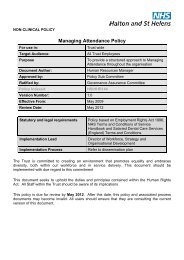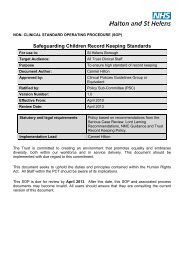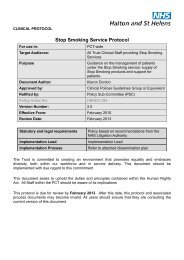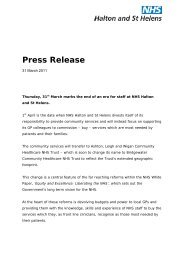Collaborative Intravenous Nursing Service (CINS) Guidelines
Collaborative Intravenous Nursing Service (CINS) Guidelines
Collaborative Intravenous Nursing Service (CINS) Guidelines
- No tags were found...
Create successful ePaper yourself
Turn your PDF publications into a flip-book with our unique Google optimized e-Paper software.
• Open sterile pack allowing inner pack to fall onto clean working area.• Open out sterile pack to create a sterile field. Open remaining equipment ensuring nocontamination of sterile field. Place 0.9% Sodium Chloride (saline) and Heparinisedsaline ampoules near to the working area but not on the sterile field.• Pour out alcohol Chlorhexidine solution.• Ensure easy access to the needle free system.• Put on sterile gloves. Connect needle or filter straw to the syringe.• Pick up a piece of sterile gauze and with it pick up the 0.9% Sodium Chloride forinjection ampoule, then draw up 10ml of solution, Repeat for second 0.9% SodiumChloride and Heparin 10units/ml in 0.9% Sodium Chloride. Dispose of the needledirectly into the sharps container. Place the filled syringes on the sterile field.• Place sterile towel as near as possible to the catheter.• Using a piece of sterile gauze soaked in 2% Chlorhexidine solution, scrub the top thenthe sides of the needle free system connection and allow to dry.• Alternatively, scrub the hub of the needle free system with 2% Chlorhexidineimpregnated wipe, rubbing from the top of the needle free connector to the sides. Dothis three times using different parts of the wipe, over a period of 30 seconds. Allow todry.• Attach syringe with 0.9% sodium chloride for injection, aspirate enough blood to colour0.9% Sodium Chloride solution then inject the flush using a push pause actionclamping as the last ml of the solution is instilled into the catheter. Remove the syringeand discard.• If unable to aspirate blood from the line continue to administer prescribed medicationunless this is a vesicant drug/infusion, in this case refer to algorithm onpersistant withdrawal occlusion.• NEVER FORCE THE SOLUTION INTO THE CATHETER, this can easily damage thecatheter.• Administer IV antibiotics/infusion/additives as prescribed following trust policy.• Flush catheter again with 10ml 0.9% Normal Saline using a push/pause action.• Remove the syringe and discard.• If open ended skin tunnelled catheter and this is the final dose of treatment for the day,repeat this procedure using Heparin 10units/ml in 0.9% sodium chloride clamping asMaintain asepsis.To check catheter patency and toremove residual solution from catheter.The RCN Standards for infusion Therapystate, “the nurse should aspirate thecatheter and check for blood return toconfirm patency prior to theadministration of medications and/orsolutions (INS 2000). On no accountshould a vesicant drug or vesicantinfusion be administered through avascular access device where difficulty isexperienced in withdrawing blood(Masoorli 2003).Creates turbulence in catheter,preventing clotting in the catheter.Maintains positive pressure and preventsbackflow of blood into the catheter.15The CINs group hereby assert their moral rights tothe works herein in accordance with the Data Protection Act 1988.Policy review date 01/10/10


